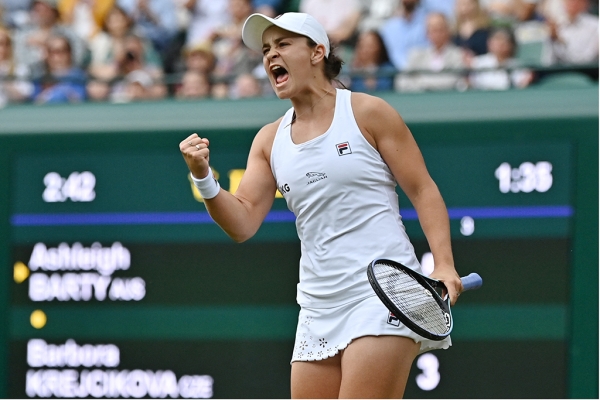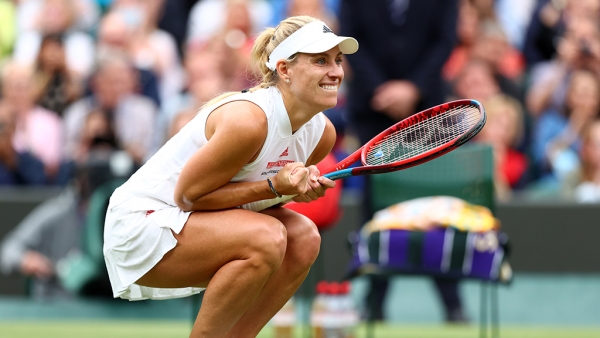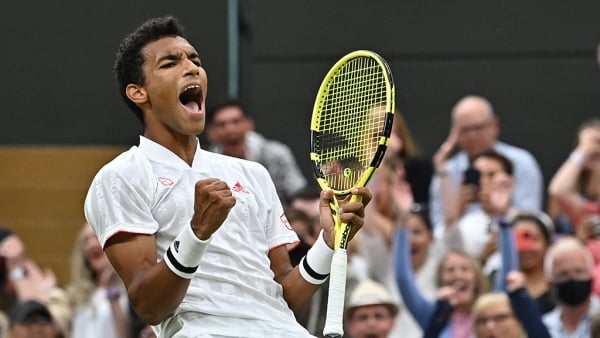The tennis world welcomed back Wimbledon this year following its cancellation in 2020, and the Championships delivered a heart-warming and historic 2021 edition.
Two weeks of grass-court action concluded at the All England Club on Sunday, and these are our key takeaways from the third Grand Slam tournament of 2021.
Barty the undisputed world No.1
The Australian’s emotional victory in the women’s singles final over Karolina Pliskova saw Barty achieve a childhood dream – and cement her status as the world’s premier player.
As she sat out the majority of 2020 due to the COVID-19 pandemic, and Naomi Osaka won back-to-back majors at the US and Australian Opens, some questioned Barty’s legitimacy as the world’s top-ranked player.
Yet the 24-year-old has completely extinguished such commentary by establishing herself as the WTA’s most consistent, multi-surface force.
BARTY: Wimbledon win "most incredible feeling I've experienced on court"
After a strong start to 2021 on home soil, Barty produced a resounding title run on Miami’s hard courts before hitting the clay, where she won the Stuttgart title (indoors) and reached the Madrid final (outdoors). Then came the finest performance of her career at Wimbledon, on grass, for her fourth title of the season.

Enhancing this achievement was the calibre of opponent; in the second week alone she defeated reigning Roland Garros champion Barbora Krejcikova, resurgent three-time major winner Angelique Kerber and former world No.1 Karolina Pliskova.
Barty now owns a tour leading win-loss record this year of 35-6.
Djokovic’s achievements thrilling for stats fans
The world No.1 has declared it his mission to achieve tennis history, and with his Wimbledon triumph on Sunday, he continued doing just that.
After becoming the first man in 52 years to win the first three major trophies of a single season, Djokovic equalled the men’s record of 20 Grand Slam singles titles won, shared by Roger Federer and Rafael Nadal.
DJOKOVIC: "I'm probably the most complete I've been as a player"
He had won 18 consecutive sets coming into the Wimbledon final, and while Berrettini snapped that streak by taking the first set, Djokovic ultimately won his 18th straight match, improving both his Grand Slam match-winning streak, and grass-court winning streak, to 21 matches.
Djokovic has not lost since the Rome final two months ago, when Nadal beat him.
??: ?
— #AusOpen (@AustralianOpen) July 12, 2021
??: ?
??: ?
??: ❓
Third major trophy of the season for @DjokerNole and the calendar-year Grand Slam in sight ? pic.twitter.com/wxqZG3weai
He has now won eight of his past nine major finals, and six of his seven Wimbledon finals, taking a step closer to Federer’s record of eight singles trophies at the All England Club.
And the Serb is now starting to notch age-related milestones; he has won a record eight majors titles since turning 30 and is the second-oldest Wimbledon men’s singles champion in the Open Era.
Djokovic joins a select group – also featuring Federer, Bjorn Borg and Pete Sampras – to have won three straight Wimbledon men’s singles titles in the Open Era.
And he will shoot for the most incredible of achievements at the US Open, bidding to become just the third man in history – and the first since Laver in 1969 – to win all four Grand Slam singles titles in a calendar year.
The last player to complete the feat in singles was Steffi Graf 33 years ago.
Wimbledon restorative for women’s fortunes
This year’s tournament saw the welcome return to form of several popular women’s champions.
Kerber’s turnaround was perhaps the most significant; the German, after slipping to No.28 in the rankings, posted her best Grand Slam result since 2018 after winning her first WTA title in three years at Bad Homburg.
“I still have the passion for the sport, (knowing) that I played great matches against the best players in the world,” said 33-year-old Kerber, whose 10-match winning streak ended against Barty.

Pliskova went a step further, progressing to her first Grand Slam final since 2016 and rediscovering her confidence after failing to win a match on grass leading in and slipping outside the top 10 for the first time in five years.
There were great results for 2017 major champions Sloane Stephens – who upset Petra Kvitova en route to the third round – and Jelena Ostapenko, who won the Eastbourne title and built a seven-match winning streak in progressing to the third round at SW19.
Former top-10 player and major finalist Madison Keys reached the last 16, her best Grand Slam result in two years.
It bodes well for the US Open, where almost all of these players have traditionally performed well.
Status quo maintained in men’s game
Following Roland Garros, we speculated whether younger players not named Djokovic, Nadal or Federer would now begin winning Grand Slam titles.
But Wimbledon proved the game's current power structure remains firmly entrenched.
We had new young semifinalists in Berrettini, Hubert Hurkacz and Denis Shapovlov, the youngest of that trio at 22 years of age. Felix Auger-Aliassime, just 20, reached his first major quarterfinal.

Ultimately, Djokovic again proved both his durability and superiority.
REPORT: Djokovic beats Berrettini for 20th major title
The US Open traditionally offers a wider variety of champions – most recently Juan Martin del Potro, Marin Cilic, Stan Wawrinka and Dominic Thiem – but there may not be a new winner in 2021.
Djokovic enters as a hot favourite, four-time champion Nadal returns to a tournament he loves, and Federer continues building in his comeback, going one round further at Wimbledon than he did in Paris.
It’s a positive outcome regardless – either the next generation breaks through to create a significant baton-passing moment, or they don’t, allowing the vaunted ‘Big Three’ to continue creating history.
20-20-20 vision ?
— #AusOpen (@AustralianOpen) July 11, 2021
Who will finish with the most major titles? ? #Wimbledon pic.twitter.com/qKYFwFEFTn
Crowds generate emotion
Wimbledon was notable for becoming the first Grand Slam tournament to feature capacity stadium crowds from the quarterfinals onwards.
It created an incredible energy for everyone involved, including spectators in attendance and millions more watching around the world.
The players were particularly appreciative of this, having competed before sparse stands at many events throughout the past year while existing in a COVID-safe “bubble” on tour.
Pliskova articulated it best when explaining the factors prompting her tears during the women’s final trophy presentation.
“I thought the crowd was amazing. I felt like so much support from the crowd. I enjoyed also, of course, Princess Kate was there. I saw all these people just being there. They cheered so much. Just like too many emotions,” she reflected.
With the US Open also announcing it will feature capacity crowds in 2021 after no spectators were allowed in 2020, expect more excitement, atmosphere and drama as the Grand Slam season concludes in New York.